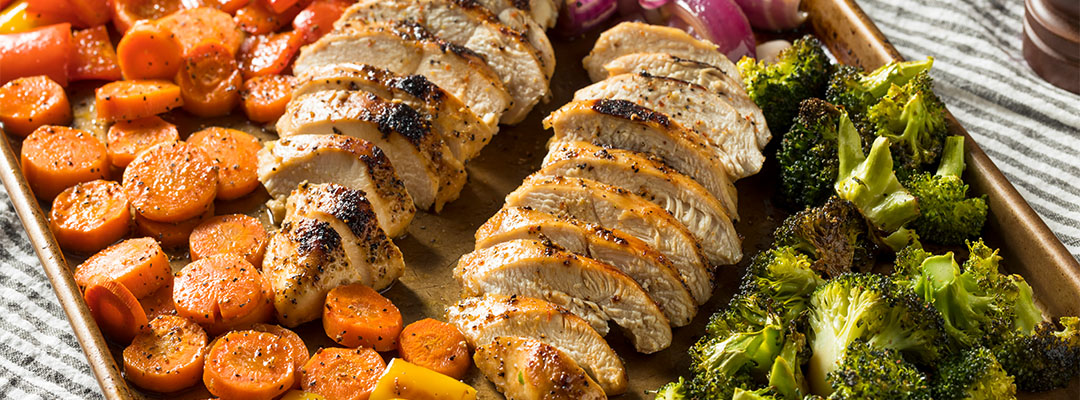
Now more than ever, cooking at home has multiple benefits. More control over ingredients, preparation methods and portion sizes typically lead to healthier eating choices. Plus, it can save you money. By mastering a few key principles, a world of options is at your fingertips. You don’t even really need a recipe! Read on as the team at Good Measure Meals shares some basic concepts that will empower you to create quick, nutritious and delicious meals.
The Building Blocks of a Balanced Meal
Pick Your Protein: Protein powers your muscles and keeps you satisfied. Aim to include a variety of lean animal protein in your meals, such as skinless poultry, fish, seafood, eggs, lean cuts of beef, and pork. Incorporating plant-based sources of protein, such as tofu, beans, and lentils, benefits your heart, your wallet and the environment.
Select Your Starch: Starchy foods provide complex carbs, the best energy source for your body, and your brain. Choosing fiber-rich versions means more stable blood sugar and cholesterol levels, lowering risk for diabetes and cardiovascular disease while promoting healthy digestion. Think whole grains such as brown rice, quinoa, farro, couscous, and whole wheat bread and pasta. Starchy veggies like potatoes, corn and peas are also great sources.
Volumize with Veggies: Naturally low in calories, high in fiber and packed with antioxidants, vitamins, and minerals, veggies are an essential part of a healthy diet and great way to boost the volume and nutrient density of your meal. Choose veggies in the season for the best flavor and highest nutrient content. For Fall, that means Brussels sprouts, butternut squash, beets and carrots to name a few.
Add Flavor with Fat … and herbs, spices and aromatics: Fat has many important roles in cooking– adding flavor and mouthfeel, enhancing absorption of fat-soluble vitamins (A, D, E, K), helping us feel fuller longer, and perhaps most importantly – making food taste good! Choose heart-healthy, unsaturated fats more often, like using olive oil for dressings and marinades, and topping side dishes with nuts, seeds and avocado.
Finally,
Consider Your Cooking Method: Grilling, roasting, sautéing, and steaming are lower fat, healthier ways to prepare foods. Limit cooking methods that add copious amounts of fat, like deep frying. Choose olive oil or other plant-based unsaturated fats (i.e. avocado, walnut, safflower or canola oil) to coat ingredients before cooking.

Once you’ve mastered these key concepts and selected your “building blocks,” the next step is getting comfortable utilizing the different tools in your kitchen to prepare them into a balanced, tasty meal. Let’s explore!
Cooking Methods
OVEN: One pan, endless possibilities.
- Place your protein (such as chicken or fish) on a baking sheet or roasting pan along with white, red or sweet potatoes and 1-2 other veggies of choice. Coat ingredients with a marinade first, or even just olive oil, salt, and pepper. Add herbs, spices, and onions if desired. Roast at 400 degrees F until protein reaches safe internal temperature and veggies achieve desired brownness.

GRILL: Take it outdoors – or indoors with a stovetop or portable grill.
- Grill your protein – try skinless chicken breast or burger patties made with lean ground turkey or beef
- Grill your veggies – slice and coat with olive oil; try asparagus, bell peppers, onions, squash, zucchini or portabella mushrooms
- Serve protein on a whole grain bun, plus extra lettuce and tomatoes if desired
- Another fun idea is to make skewers with cubed veggies and chicken or shrimp; coat with olive oil before grilling and serve with a whole-grain roll or grilled corn. If you’re feeling fancy, enjoy with a grain or bean salad
STOVE-TOP: One pot and one pan are all you need to create a delicious, balanced meal on your stove.
- Start simply by heating oil in a pan. Then add your protein – chicken, shrimp, fish, ground turkey/beef, or tofu are all great options. Cook these before adding veggies, as they take longer.
- Next, add fresh (or frozen) veggies to the pan. Try a combo of peppers and onions for a Mexican-style meal, or water chestnuts, snow peas, broccoli and carrots for an Asian-style dish.
- In a separate pot, cook a whole grain (such as brown rice, quinoa, or pasta) with water or stock according to package directions.
- Serve protein and veggies over the grain, adding additional sauce if desired (i.e. marinara, teriyaki)
CROCK-POT: The perfect tool for creating moist, flavorful, one-pot dishes, a crock-pot is a kitchen staple worth investing in if you don’t own one already.
- Simply place your protein, prepared vegetables and starch (potatoes work great here) along with desired seasonings and/or sauce inside the main bowl and set the timer. A few hours later, you’ll have a hearty, complete meal, and only one pot to clean!
Like any of the methods above? Let us know on Facebook, @MizunoNorthAmerica, or Instagram, @MizunoNorthAmerica!

Alissa Palladino, MS, RDN, LD, ACSM-CPT
Alissa is a Registered Dietitian at Good Measure Meals where she helps people achieve and maintain their health goals. A veggie lover and avid runner with a number of half and full marathons under her belt, she believes the best form of exercise is the one you enjoy and the best nutrition plan is one that fits into your lifestyle.
Updated: March 2020
Need a new pair of running shoes? Check out the Wave Horizon 4!
